

Original Article - Year 2014 - Volume 29 -
Bibliometric analysis of articles published in the Brazilian Journal of Plastic Surgery from 2005 to 2012. Part II: source, previous presentations, and types of articles
Análise bibliométrica dos artigos publicados na revista brasileira de cirurgia plástica entre 2005 e 2012. Parte II: serviços de origem, apresentações prévias e tipos de artigos
ABSTRACT
INTRODUCTION: Although bibliometry has been used to characterize scientific results in numerous national and international journals, bibliometric data on scientific publications related to plastic surgery are scarce. Therefore, this study analyzed articles published in the Brazilian Journal of Plastic Surgery (BJPS), the official journal of the Brazilian Society of Plastic Surgery (BSPS).
METHODS: A quantitative bibliometric analysis of all articles published in the BJPS between 2005 and 2012 was performed. Information regarding presentation of the work at scientific meetings, institution type (BSPS-accredited or not), and article category were extracted from the articles included in this study. Data from two time periods (2005-2008 and 2009-2012) were analyzed and compared.
RESULTS: A total of 603 scientific articles fulfilled the insertion criteria. Most articles were from accredited services institutions (58.21%), had not been presented at scientific meetings (84.74%), and were published as original articles (78.77%) in the BJPS (p<0.05 for all comparisons). Comparative analysis revealed a significant reduction in the proportion of review articles and a significant increase in the proportion of scientific articles that had not previously been presented at scientific meetings in 2005-2008 compared to 2009-2012 (p<0.05 for both).
CONCLUSION: This survey revealed a prevalence of original articles published by BSPS-accredited institutions that were not presented at scientific meetings.
Keywords: Bibliometry; Plastic surgery; Scientific publications; Periodical publications; Journal of Plastic Surgery.
RESUMO
INTRODUÇÃO: Embora a bibliometria tenha sido aplicada na caracterização dos resultados científicos de inúmeros periódicos nacionais e internacionais, dados bibliométricos sobre a produção científica da cirurgia plástica brasileira são escassos. Assim, o objetivo deste estudo é analisar os artigos publicados na Revista Brasileira de Cirurgia Plástica (RBCP), periódico oficial da Sociedade Brasileira de Cirurgia Plástica (SBCP).
MÉTODOS: Trata-se de uma análise bibliométrica, quantitativa, de todos os artigos publicados entre 2005 e 2012 na RBCP. Informações referentes à apresentação em eventos científicos, aos tipos de instituição (credenciadas ou não pela SBCP) e a categoria dos artigos foram extraídas dos artigos incluídos. Dados de dois períodos (2005-2008 versus 2009-2012) foram analisados, comparativamente.
RESULTADOS: Um total de 603 artigos científicos preencheram os critérios de inclusão. A imensa maioria (p<0,05 para todas as comparações) desses artigos foi proveniente de Serviços Credenciados pela SBCP (58,21%), não foi apresentada em eventos científicos (84,74%) e foi publicada na seção artigo original (78,77%) da RBCP. A análise comparativa entre os períodos revelou uma redução significativa (p<0,05) na proporção de artigos de revisão (2005-2008>2009-2012) e um aumento significativo (p<0,05) na proporção de artigos científicos que não foram apresentados previamente em eventos científicos (2005-2008<2009-2012).
CONCLUSÃO: Esta investigação revelou um predomínio de artigos publicados na seção artigos originais, provenientes de Serviços Credenciados pela SBCP, e que não foram apresentados em eventos científicos.
Palavras-chave: Bibliometria; Cirurgia plástica; Publicações científicas; Publicações periódicas; Revista de Cirurgia Plástica.
The advent of scientific journals is one of the most defining characteristics of modern science. After World War II, articles published in this media format have become the main route for dissemination of scientific knowledge. Evaluation of the scientific productivity of authors, research groups, departments, institutions, and journals themselves has become extremely relevant1.
In this context, bibliometry, a set of mathematical methods used to analyze and measure productivity indices and dissemination of scientific knowledge,2 has been used to provide information on pattern, process, volume, evolution, visibility, and search structure of diverse national and international journals, including journals in the field of plastic surgery3-6. Although this topic is important, analysis of the production, communication, and dissemination of scientific articles remains scarce in national literature in the field of plastic surgery5,6.
Because continuous analysis of publication profiles is a necessary part of promoting research activity in specific scientific fields by informing readers, authors, editorial board, and academic and government institutions, we conducted a bibliometric study on scientific articles published between 2005 and 2012 in the Brazilian Journal of Plastic Surgery (BJPS), the official journal of the Brazilian Society of Plastic Surgery (BSPS).
In Part I of our analysis, we presented data on the number of articles published annually, the number of authors per article, and the geographic origin of the articles. Following that bibliometric analysis, this study (Part II) evaluates the evolution of articles published in the BJPS based on institution, previous presentation at scientific meetings, and article category or journal section.
METHODS
A quantitative bibliometric study was conducted2 on all articles published in the BJPS between 2005 and 2012 (volume 20, number 1 - volume 27, number 4). In order to characterize the evolution of scientific production of the BJPS, the study period was subdivided into two time periods, 2005-2008 and 2009-2012. In this study, only information about the institution (BSPS accredited or non-accredited), previous presentation at scientific meetings, and article category or journal section (original article, review article, or case report) were analyzed. Additional information about search strategies, selection criteria (inclusion and exclusion), and data extraction are detailed in Part I.
Statistical analysis
The data were compiled in Excel 2013 for Windows (Office Home and Student 2013, Microsoft Corporation, USA) and all analyses were conducted using SPSS Statistics for Windows version 17 (SPSS Inc., Chicago, IL, USA). For the descriptive analysis, averages and percentages were used for metric and categorical variables, respectively. Comparative analyses were conducted using analysis of variance (ANOVA) and equality of two proportions using confidence intervals of the means. Values were considered significant for 95% confidence intervals (p<0.05).
RESULTS
The BJPS published a total of 722 scientific articles during 2005-2012. After excluding 119 (16.48%) articles, a total of 603 (83.52%) articles were included in this analysis. Of these, 187 (31.01%) and 416 (68.99%) articles were published in 2005-2008 and 2009-2012, respectively.
BSPS accredited and non-accredited institutions
A total of 351 (58.21%) articles from 2005-2012 were published by BSPS accredited services institutions, and 252 (41.79%) by non-accredited institutions (p<0.001, Figures 1 and 2). Comparative analysis of the two time periods found no significant difference (p=0.837) in the proportion of contributions from accredited and non-accredited institutions (110 [58.82%] articles from accredited institutions in 2005-2008 versus 241 [57.93%] in 2009-2012 compared to 77 [41.18%] and 175 [42.08%] articles from non-accredited institutions in 2005-2008 and 2009-2012, respectively).
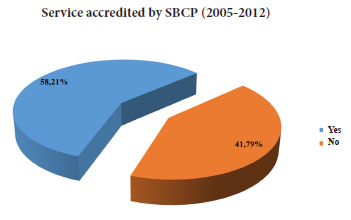
Figure 1. Institutions that published scientific articles in the Brazilian Journal of Plastic Surgery between 2005 and 2012 according to Brazilian Society of Plastic Surgery (BSPS) accreditation (n=603).
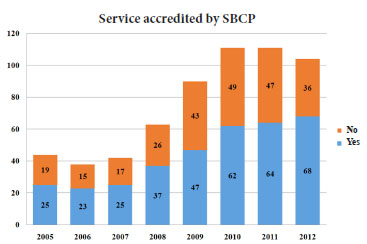
Figure 2. Institutions that published scientific articles in the Brazilian Journal of Plastic Surgery between 2005 and 2012, according to Brazilian Society of Plastic Surgery (BSPS) accreditation (n=603).
Most scientific articles published over 2005-2012 were not presented at scientific meetings (511 articles, p<0.001). Only 92 articles published in the BJPS had been previously presented (Figures 3 and 4). However, analysis of the two time periods revealed a significant increase (p<0.001) in the proportion of scientific articles not presented in scientific meetings (141 [75.40%] articles not previously presented in 2005-2008 versus 370 [88.94%] articles not previously presented in 2009-2012) compared to the proportion of articles that were presented before publication (46 [24.60%] articles previously presented in 2005-2008 versus 46 [11.06%] in 2009-2012).
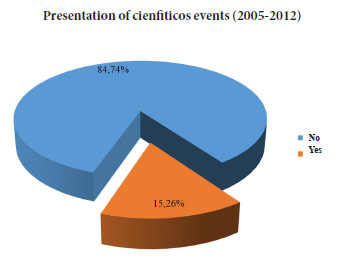
Figure 3. Scientific articles published by the Brazilian Journal of Plastic Surgery between 2005 and 2012 according to presentation at scientific meetings (n=603).
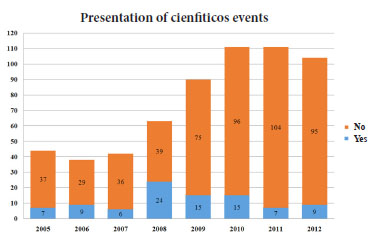
Figure 4. Scientific articles published by the Brazilian Journal of Plastic Surgery between 2005 and 2012 according to presentation at scientific meetings (n=603).
Article categories
Most of the articles (475) were published as original articles in the BJPS (p<0.001 for all comparisons). The remaining articles were case reports (99 articles) and reviews (29 articles) (Figures 5 and 6). Comparative analysis of the time periods revealed a reduced proportion of review articles (7.49% [14 articles] in 2005-2008 versus 3.60% [15 articles] in 2009-2012; p<0.039) but no significant differences in the proportion of original articles (140 [74.87%] in 2005-2008 versus 335 [80.53%] in 2009-2012; p=0.116) and case reports (17.65% [33 articles] in 2005-2008 versus 15.86% [66 articles] in 2009-2012; p=0.585).
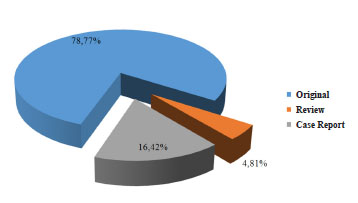
Figure 5. Scientific articles published in the Brazilian Journal of Plastic Surgery between 2005 and 2012 according to article category or journal section (n=603).
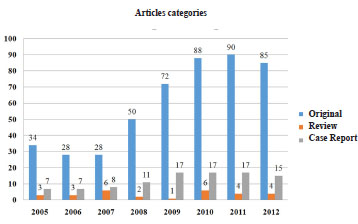
Figure 6. Scientific articles published by the Brazilian Journal of Plastic Surgery between 2005 and 2012 according to article category or journal section (n=603).
DISCUSSION
Bibliometry is useful for determining current characteristics, evaluating scientific advances, and providing data to define the future of research in specific fields of medical science2. Thus, similar to findings in a recent bibliometric evaluation of a Brazilian journal7, the results of this analysis provide an opportunity to reflect on current BJPS publication trends (2005-2012 and 2005-2008 versus 2009-2012) and also allow planning for the future (i.e., set targets for upcoming years).
Accredited and non-accredited BSPS institutions
This study revealed a significant predominance 8.21%) of scientific articles from BSPS-accredited institutions. Although other analyses4,5 have classified institutions as philanthropic, private, public, or academic, we have differentiated between BSPS-accredited and non-accredited institutions, since it is clear that contributions (or their lack) from the more than 80 accredited services institutions of the BSPS have had an impact on numerous editions of the BJPS8,9.
It is important to note that the data presented in this study supports criticisms and hard questions posed by several published editorials8,9. This bibliometric analysis demonstrated that although the total number of articles published in the BJPS has significantly increased, the proportion of contributions from accredited services institutions has not (58.82% in 2005-2008 versus 57.93% in 2009-2012; p>0.05). Thus, this continuous contribution is above the required minimum to reach levels and goals that required by the BPS8.
In the scientific world, the Cartesian thesis (I think, therefore I am) is reversed (I am because I am thought and not because I think)10. Unfortunately, only a fraction of Brazilian plastic surgeons are concerned with publishing11, similar to observations in the surgical field12. The Second Article of the Accredited Services regulations addresses the importance of these publications as one of its three basic standards; these standards should be followed by the accredited services institutions, which have committed to submit at least two articles each year to the BJPS; however in 2008 and 2009, 70.13% and 62.34% of institutions, respectively, did not submit articles9. Such data reflect the limitations that Brazilian plastic surgeons have in writing and publishing articles9, in particular in the BJPS, which is the only national journal aimed exclusively at plastic surgery.
In this context, no one can guess what happens in the laboratory of a researcher, or what results are attained by a plastic surgeon using a given technique, if these research activities are not transmitted to the public through scientific articles10. Therefore, publication of plastic surgery findings is the only way to perpetuate, discuss, prove, and even question new ideas11. The BJPS has encouraged BSPS members to publish complete articles, demonstrating that, on average, each accredited service reports a minimum of 400 surgical interventions each year and the size of the research database is directly related to accreditation time9. Either way, these efforts have not influenced the number of contributions, which have not yet reached an acceptable number. This study demonstrated that although overall contributions have mostly been from Accredited Services institutions, comparative analysis of different time periods revealed similar proportions of contributions from accredited and non-accredited institutions. All Accredited Services members receive updated numbers from the BJPS and should therefore increase their submission of articles to the BJPS.
Additional measures are necessary to stimulate change and transform inertia into action. Alternatives that would induce members to publish, such as submission of complete articles as a mandatory requirement to be considered for society Board membership, have been discussed11.
However, a stricter rule was established at the BSPS Deliberative Council meeting in August 2012. In this meeting, a policy was instituted requiring submission and publication of scientific articles in the BJPS for members of the BSPS Board of Directors, Regional Board of Directors, Editorial Board of the BJPS (Chief Editor, Co-Editor, Associate Editors, and Reviewers), the DEC, DESC, and Specialist Commissions, Holders and Awards, in addition to the tax applied to chiefs, lecturers, and residents of Accredited Services institutions. If the goals to publish one article every one or two years are not achieved, punitive measures such as demotions and preventing specialist examinations will be applied to BSPS members and institutions.
However, imposing these measures with the aim of increasing the number of articles published in the BJPS without also establishing robust and progressive educational measures and a bibliometric map of the scientific scenario of each accredited institution may not produce the desired effects. In the simple "number" context of scientific articles (regardless of article quality or the research relevance), it is interesting to note that official BSPS events often favor professionals with low or inconsistent scientific publication records over those with great or consistent records.
Therefore, similar policies between the BJPS and the BSPS management could promote a "scientific meritocracy," prioritizing and promoting members with scientific merit; that is, those with consistent qualitative and quantitative scientific publication records, with the aim of promoting the so desired and required increase in the scientific production. This path would likely be more natural and democratic, with no need for impositions or penalties.
Furthermore, we believe that the increased number of articles submitted for publication by the BJPS could also depend on the authors or research groups themselves: more experienced authors may offer support, help, and encouragement to less-experienced authors and groups13,14. Following this idea, similar to reports from the Editorial Board of the Brazilian Vascular Journal (JVB)12, alternative strategies may be adopted by the BJPS and BSPS to increase the article submission rate, includng: meeting registration discounts or exemptions for authors who have published articles in the journal in the preceding two years, or registration exemptions for authors of the 10 articles with the greatest number of downloads from sites such as SciELO.
We therefore suggest that the BJPS Editorial Board should maintain, through a "Continuous Update" section or the previous "Message from the Educational Foundation BSPS" section, important information about scientific methodology, as a way to promote and educate young Brazilian plastic surgeons, as well updates for more experienced surgeons. Promotion of scientific methodology courses may also be valuable.
An important limitation in the above-mentioned discussion of the limited contributions by BSPS-accredited institutions is that studies conducted by Brazilian plastic surgery researchers and published in other journals were not considered. The total number of articles by Brazilian contributors published in the international peer reviewed journals Plastic and Reconstructive Surgery [PRS], Annals of Plastic Surgery [AnPS], British Journal of Plastic Surgery [BJPS] and European Journal of Plastic Surgery has been reported by other bibliometric studies5,6 and is beyond the scope of this analysis.
Presentations at scientific meetings
Although the abstracts presented in congresses and scientific meetings contribute to dissemination of up-to-date research for participants and their peers through re-transmission of information, the comprehensiveness of this dissemination is limited to the people who attend a specific session (or room) of the meeting15. Therefore, these abstracts should be published as complete articles in scientific journals with the aim to consolidate the quality and validity of the scientific research, increase information dissemination, and preserve the information15.
Thus, this study found that only a small proportion (15.26%) of articles published in the BJPS between 2005 and 2012 had been presented at scientific meetings. A similar study5 revealed that 36% of articles published in three international journals in the field of plastic surgery (PRS, AnPS, and BJPS) in 2002 had been presented at scientific meetings. It is worth mentioning that the number of articles presented at scientific events may be higher than described here, since the authors may not have provided this information during the submission process, or the articles included in this analysis may have been presented after publication5.
Although Part I of this bibliometric analysis reported a significant increase in the number of articles published in the BJPS between 2005-2008 and 2009-2012, the same was not true for the rate of articles published that had been presented at scientific events (46 [24.60%] articles in 2005-2008 versus 46 [11.06%] in 2009-2012; p>0.05). The increase in the total number of articles published in the BJPS could have been much higher if a higher percentage of the abstracts presented at meetings had resulted in complete articles16,17.
In fact, there seems to be a gap between the large number of abstracts presented at annual and biannual national meetings (for example, the Brazilian Congress of Plastic Surgery, DESC Congress, or other Congresses in fields where plastic surgery operates, such as the Brazilian Congress of Craniomaxillofacial Surgery) and those that are published as articles. Data from the national surgical literature are scarce, but one study17 reported a great discrepancy between the number of abstracts presented at meetings of the Brazilian Society of Angiology and Vascular Surgery (SBACV) and the publication subsequent rate of complete articles (6.23% of total abstracts). This percentage is extremely low when compared with the international average of 44.5% described in a systematic review18.
In the field of plastic surgery, 20%, 38.7%, 45%, and 63.7% of presentations given at meetings of the British Association of Plastic, Reconstructive and Aesthetic Surgeons (2007), Congress of the Korean Society of Plastic and Reconstructive Surgeons (2005-2007), Canadian Society of Plastic Surgeons, American Society of Plastic Surgeons, and American Association of Plastic Surgeons (2003-2007), and European Association of Plastic Surgeons (1995-1999), respectively, were published as scientific articles in the years following these meetings13,14,19-21.
There are many possible explanations for the lack of publications from meeting abstracts, including lack of time, priorities, resources, and confidence in research quality, rejection of submitted articles, problematic relations between co-authors, and similar published articles13,14,21. The scientific experience of the authors or research groups and pressure from peers and research institutions may also affect conversion rates21.
Another important aspect is publication bias: the tendency to publish research results based on the perceived relative impact of the findings, where significant results tend to be published more quickly than insignificant or null results and negative results are less likely to be published8,22. Plastic surgery authors like to present their best results, and complicated findings or solutions appear rarely in the literature8.
Innovative research or surgeries presented first in scientific meetings are reliable only after being published as complete scientific articles12. One of the most striking examples to support this view occurred in 1967, during the fourth congress of the International Society of Plastic Surgery, later known as the International Plastic, Reconstructive and Aesthetic Surgery (IPRAS). During the meeting plastic surgeon Dr. Paul Tessier presented principles and techniques for correction of patients with Crouzon, Apert, and hypertelorism syndromes. Although Dr. Tessier's presentation was well received by the plastic surgeons present at the meeting, including Sir Harold Gillies, Tord Skoog, Varaztad Kazanjian, and Samuel Pruzansky, it was only after his first publications in both French and American journals23-26, that his principles and techniques spread worldwide and made Dr. Paul Tessier one of the most important names in the history of medicine27,28.
Dr. Joseph E. Murray, a plastic surgeon, Nobel Prize winner, and organ transplant pioneer, emphasized that "the abstract is only an ongoing work"21. Thus, it is important to convert abstracts into complete articles regardless of the scientific results (positive or negative; significant or not; excellent or bad results; with or without complications, among other aspects) both to disseminate advances in the field of plastic surgery, minimize redundant research, and reduce delays in dissemination of new strategies that could assist patients14.
In order to improve the conversion rate of abstracts into articles, as many international and national societies12,13,16, the Editorial Board of the BJPS, and the BSPS have relentlessly and repeatedly stimulated the more than 5000 members of the BSPS to transform their meeting abstracts into complete articles. For example, the Editorial Board of the Brazilian Vascular Journal (JVB)12 reported that abstracts considered for awards at the SBACV meetings should be submitted as complete text, and selected abstracts would automatically be accepted as original articles in the JVB, similar to the BSPS requirement for full members to submit abstracts and articles to qualify for research awards at the national meetings.
However, despite these efforts, only a fraction of the membership has followed this practice8,9,11, as partially demonstrated in our results. Promoting a culture of publishing, developing research abilities under the guidance of experienced research teams, and ensuring enough time for surgeons to publish their work may improve or increase the conversion rate13,14 and, therefore, reduce the "lost science of the third world"16,17.
Study categories
Although another bibliometric study5 included only original articles published in the field of plastic surgery (PRS, AnPS, and BJPS), the present work (Parts I, II, and III) analyzed original articles as well as review articles and case reports since review articles and case reports may contain high-quality reviews of methodologies and case reports (as opposed to isolated cases), which may impact the analyses that will be presented in the next article of this series (Part III: study design and evidence levels).
The present analysis revealed a significant predominance of original articles (78.77%) in the BJPS, similar to other journals3,29. This analysis also revealed that the proportion of case reports in the BJPS was consistent across time periods (17.65% in 2005-2008 versus 15.86% in 2009-2012; p>0.05).
In this context, the current pressure by journals to increase impact factors has resulted in drastically decreased publication of case reports1; however, it is important to highlight that the first incentive for a young surgeon to publish may be a rare or innovator case report; this is a good starting point since it may promote scientific curiosity, the desire to do research, and also stimulate innovation1. Therefore, a "case reports" section should be maintained and promoted by the Editorial board of the BJPS, always with a goal to increase the quality and relevance of the reports, which should mainly report situations of extreme rarity. Exposure to individual clinical and surgical experiences may persuade surgeons or clinicians to take similar cases or even promote the development of new case reports30.
In this context, case reports and original articles should be published in proportions determined by international indexing systems. That is, when increasing the number of case reports in an edition, the number of original articles might be increased in a 1:5 proportion.
Interestingly, this study found a significant reduction in the proportion of review articles published by the BJPS (7.49% in 2005-2008 versus 3.60% in 2009-2012; p<0.05). Therefore, it is important that surgeon authors increase participation and produce more review articles, since this article format is intended to educate the readership and highlight new discoveries; these articles are typically highly cited1. Furthermore, review articles with well-applied methodologies (systematic reviews with or without meta-analyses) have been gaining more scientific relevance and also should be developed by surgeons1.
In regard to article categories and journal sections of articles, it is necessary to allow for focused information searches by authors interested in citing BJPS articles as well as readers interested in specific articles, thus increasing the range of specific knowledge in the area where the journal operates and to facilitate framing of scientific studies in the various fields where plastic surgery operates. Therefore, the BJPS Editorial Board now includes sub-categorization keywords (for example, reconstruction, experimental, hand/peripheral nerves, lower extremity, craniofacial, among others) in the first page of articles, similar to other plastic surgery journals5, a requirement which will be added in the instructions for authors and on the BJPS and BSPS websites.
CONCLUSIONS
This quantitative bibliometric study revealed a predominance of original articles from the Accredited Services of the BSPS, and that were not presented at scientific events.
REFERENCES
1. Mariette C, Piessen G, Robb WB. Publishing in surgery: how and why? Langenbecks Arch Surg. 2013;398(4):587-93.
2. Durieux V, Gevenois PA. Bibliometric indicators: quality measurements of scientific publication. Radiology. 2010;255(2):342-51.
3. Crosta F, Nishiwaki-Dantas MC, Silvino W, Dantas PE. Diversidade e freqüência dos desenhos de estudos científicos e métodos estatísticos nos Arquivos Brasileiros de Oftalmologia. Revisão sistemática dos Arquivos Brasileiros de Oftalmologia - 1993 a 2002. Arq Bras Oftalmol. 2005;68(3):339-45.
4. Ventura AG, Ventura AJ, Santos SA. Evolutive characteristics of the scientific articles published in the "Arquivos Brasileiros de Oftalmologia" between 1986 and the year 2000. Arq Bras Oftalmol. 2008;71(5):711-6.
5. Huemer GM, Bauer T, Gurunluoglu R, Sakho C, Oehlbauer M, Dunst KM. Analysis of publications in three plastic surgery journals for the year 2002. Plast Reconstr Surg. 2004;114(5):1147-54.
6. Loonen MP, Hage JJ, Kon M. Publications of plastic surgery research 1972 through 2004: a longitudinal trend analysis of three international journals. J Plast Reconstr Aesthet Surg. 2007;60(8):934-45.
7. Carvalho CR. Publications in the Brazilian Journal of Pulmonology. J Bras Pneumol. 2013;39(1):1-4.
8. Baroudi R. Editorial. Rev Bras Cir Plást. 2012;27(3)supl.1:1.
9. Baroudi R. Editorial. Rev Bras Cir Plást. 2009;24(4):1.
10. Minayo MC, Gomes R. Scientific communication: the final and indispensable stage in the scientific process. Cien Saude Colet. 2012;17(1):4.
11. Bozola AR. Bifurcação de caminhos na evolução científica da SBCP. Rev Bras Cir Plást. 2010;25(3):414.
12. Moreira RC. Why do Brazilian vascular surgeons publish so little? J Vas Bras. 2008;7(4):291-2.
13. Chung KJ, Lee JH, Kim YH, Kim TG, Ha JH. How many presentations are published as full papers? Arch Plast Surg. 2012;39(3):238-43.
14. Gregory TN, Liu T, Machuk A, Arneja JS. What is the ultimate fate of presented abstracts? The conversion rates of presentations to publications over a five-year period from three North American plastic surgery meetings. Can J Plast Surg. 2012;20(1):33-6.
15. Yoshida WB. Temas livres versus publicação. J Vasc Bras. 2005;4(4):319-20.
16. Yoshida WB. A nossa produção científica invisível. J Vasc Bras. 2005;4(2):113.
17. Yoshida WB, Holmo NF, Corregliano GT, Baldon KM, Silva NS. Indexed publications generated from abstracts of angiology and vascular surgery congresses in Brazil. J Vasc Bras. 2008;7(4):293-7.
18. Scherer RW, Langenberg P, von Elm E. Full publication of results initially presented in abstracts. Cochrane Database Syst Rev. 2007;(2):MR000005.
19. van der Steen LP, Hage JJ, Loonen MP, Kon M. Full publication of papers presented at the 1995 through 1999 European Association of Plastic Surgeons annual scientific meetings: a systemic bibliometric analysis. Plast Reconstr Surg. 2004;114(1):113-20.
20. Kain N, Mishra A, McArthur P. Are we still publishing our presented abstracts from the British Association of Plastic and Reconstructive Surgery (BAPRAS)? J Plast Reconstr Aesthet Surg. 2010;63(9):1572-3.
21. Smart RJ, Susarla SM, Kaban LB, Dodson TB. Factors associated with converting scientific abstracts to published manuscripts. J Craniofac Surg. 2013;24(1):66-70.
22. Dickersin K, Olson CM, Rennie D, Cook D, Flanagin A, Zhu Q, et al. Association between time interval to publication and statistical significance. JAMA. 2002;287(21):2829-31.
23. Tessier P. Surgical treatment of rare orbito-facial malformations. J Genet Hum. 1966;15(Suppl):322-55.
24. Tessier P, Guiot G, Rougerie J, Delbet JP, Pastoriza J. Cranio-naso-orbito-facial osteotomies. Hypertelorism. Ann Chir Plast. 1967;12(2):103-18.
25. Tessier P. Orbital hypertelorism. I. Successive surgical attempts. Material and methods. Causes and mechanisms. Scand J Plast Reconstr Surg. 1972;6(2):135-55.
26. Tessier P, Guiot G, Derome P. Orbital hypertelorism. II. Definite treatment of orbital hypertelorism (OR.H.) by craniofacial or by extracranial osteotomies. Scand J Plast Reconstr Surg. 1973;7(1):39-58.
27. Hallock GG. The plastic surgeon of the 20th century. Plast Reconstr Surg. 2001;107(4):1014-24.
28. Wolfe SA. A man from Héric: the life and work of Paul Tessier, MD, father of craniofacial surgery: Volumes I e II. S. Anthony Wolfe, MD (Standard Copyright License); 2012.
29. Población DA, Goldenberg S. Acta Cirúrgica Brasileira: visibility and accessibility of the scientific production in experimental surgery. Acta Cir Bras. 2001;16(3):115-121.
30. Goldenberg D, Baroudi R. Original articles versus case reports: the hierarchy of scientific evidence levels. Rev Bras Cir Plást. 2011;26(3):378.
1 - MD - Aspirant Member in Training of the Brazilian Society of Plastic Surgery (SBCP), Resident Doctor in Plastic Surgery from the Plastic Surgery Service "Prof. Dr. Cassio M. Raposo do Amaral" of the Institute of Plastic and Craniofacial Surgery, SOBRAPAR Hospital, Campinas, SP, Brazil
2 - MD, PhD - Full Member of the SBCP, Lecturer at the Faculty of Medicine University of São Paulo (FMUSP), Co-editor of the Brazilian Journal of Plastic Surgery (RBCP)
3 - MD, PhD - Full Member of the SBCP, and of the Brazilian Association of Cranio-Maxillofacial Surgery (ABCCMF), PhD degree, Plastic Surgery Program of the University of São Paulo (USP), Vice-President of the Institute of Plastic and Craniofacial Surgery, SOBRAPAR Hospital, Campinas, SP, Brazil
Institution: Work performed at the Institute of Plastic and Craniofacial Surgery of the SOBRAPAR Hospital, Campinas, SP, Brazil.
Corresponding author:
Rafael Denadai
Hospital de Crânio e Face SOBRAPAR
Av. Adolpho Lutz, 100 - Cidade Universitária
Campinas, SP, Brazil CEP 13083-880; Caixa-postal 6028
E-mail: denadai.rafael@hotmail.com
Article received August 17, 2013
Article accepted: July 14, 2014


 Read in Portuguese
Read in Portuguese
 Read in English
Read in English
 PDF PT
PDF PT
 Print
Print
 Send this article by email
Send this article by email
 How to Cite
How to Cite
 Mendeley
Mendeley
 Pocket
Pocket
 Twitter
Twitter